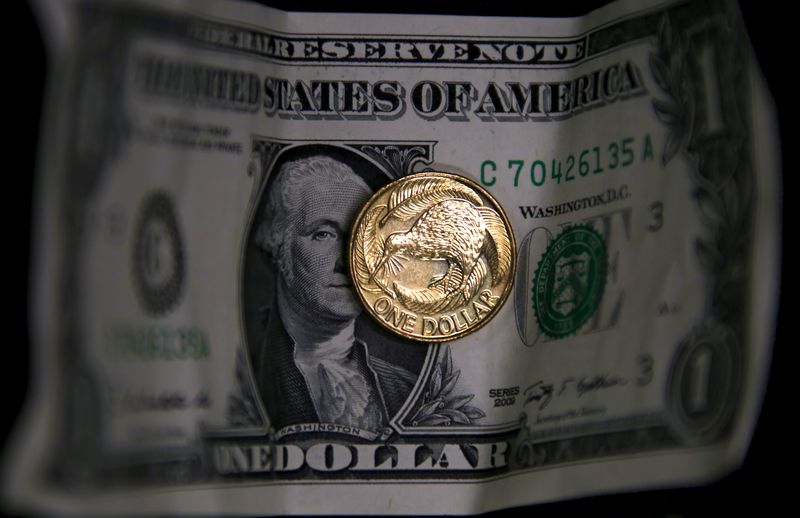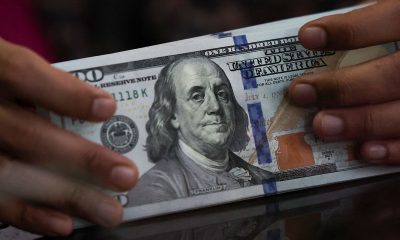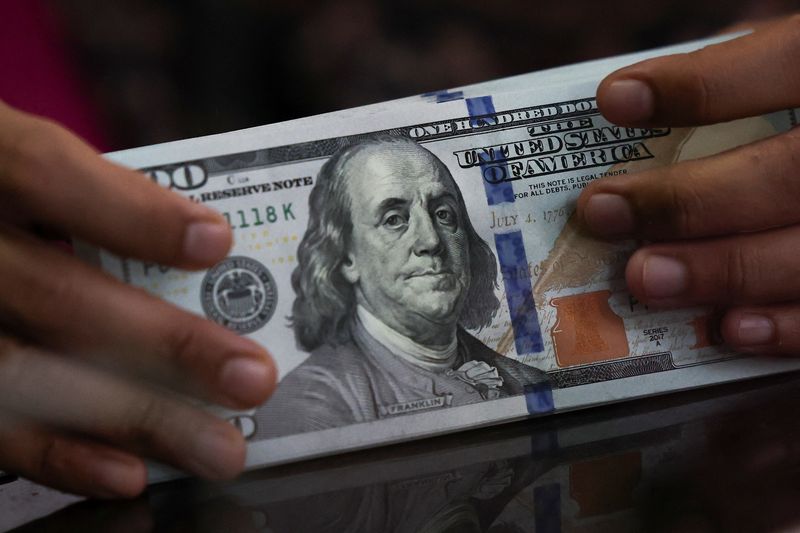Forex
US dollar gains but set for worst monthly loss in a year, euro falls


© Reuters. FILE PHOTO: A New Zealand dollar coin sits atop a United States one dollar bill in this photo illustration taken on March 11, 2016. REUTERS/David Gray/Illustration/File Photo
By Gertrude Chavez-Dreyfuss
NEW YORK (Reuters) -The dollar gained on Thursday as investors took profits on bets the currency would weaken further and shrugged off data showing signs the U.S. economy is slowing.
Thursday’s economic data suggested that the Federal Reserve is likely done raising interest rates and may start easing by the middle of next year, typically a dollar-negative factor.
Euro weakness after a soft euro zone inflation report also partly helped boost the greenback, analysts said.
The , which measures its value against six major currencies, rose 0.6% to 103.38 and was on track to post its best daily gain in more than a month. On a monthly basis, the dollar has posted a 3% loss, on pace for its worst monthly showing in a year.
Some analysts said the dollar may have benefited from month-end demand, as investors squared up positions for November, a period that featured a sharp sell-off in the U.S. currency with the market pricing in rate cuts next year.
Others, however, expected a dollar sell-off at month-end with stocks’ sharp gains for November. There were sell dollar signals at some of the biggest U.S. banks, analysts said.
“We were expecting dollar selling at month-end given how much U.S. equities rallied. That typically means foreign asset managers would have sold dollars forward,” said Vassili Serebriakov, FX strategist, at UBS in New York.
“But it’s possible that some of the selling happened earlier in the month. So maybe there’s less dollar selling at month end.”
Dollar gains persisted despite reports that showed U.S. inflation continued to moderate in October and jobless claims rose in the latest week suggesting a slowing labor market.
Inflation as measured by the personal consumption expenditures (PCE) price index was unchanged in October after climbing 0.4% in September. In the 12 months through October, the PCE price index increased 3.0%. That was the smallest year-on-year gain since March 2021 and followed a 3.4% advance in September.
Meanwhile, initial claims for state unemployment benefits increased 7,000 to a seasonally-adjusted 218,000 for the week ended Nov. 25. Economists had forecast 226,000 claims.
In other currencies, the euro fell after euro zone inflation eased by more than forecast this month, fuelling bets of early European Central Bank rate cuts.
Consumer price growth in the 20 countries that share the euro currency dropped to 2.4% in November from 2.9% in October, well below expectations for a fall to 2.7%.
The euro last changed hands at $1.0889 against the dollar, down 0.7%. It is still poised to show a monthly gain of 3%, the largest since November 2022.
Against the yen, the dollar rose 0.7% to 148.20 yen. For November, the greenback was down 2.3%, on pace for its largest monthly fall since December last year.
“The broader picture is that the dollar has weakened quite substantially in November. It’s still probably a two-way risk from here in terms of the Fed December meeting,” Serebriakov of UBS said.
“The U.S. data hasn’t slowed significantly. Inflation has but activity data remains relatively resilient,” he added.
U.S. rate futures have priced in about a 47% chance of a rate cut at the March 19-20, 2024 meeting, rising to about 78% probability at the April 30-May 1 meeting, the CME FedWatch Tool showed on Thursday. Overall, the rates market sees roughly 100 basis points (bps) of cuts by the end of 2024, according to LSEG data.
========================================================
Currency bid prices at 4:30PM (2130 GMT)
Description RIC Last U.S. Close Pct Change YTD Pct High Bid Low Bid
Previous Change
Session
Dollar index 103.4800 102.8200 +0.66% -0.010% +103.5900 +102.7100
Euro/Dollar $1.0887 $1.0969 -0.75% +1.61% +$1.0984 +$1.0879
Dollar/Yen 148.1800 147.2400 +0.64% +13.02% +148.5000 +146.8500
Euro/Yen 161.34 161.51 -0.11% +15.00% +161.9400 +160.6000
Dollar/Swiss 0.8753 0.8737 +0.19% -5.33% +0.8770 +0.8681
Sterling/Dollar $1.2625 $1.2695 -0.55% +4.40% +$1.2710 +$1.2604
Dollar/Canadian 1.3564 1.3589 -0.18% +0.11% +1.3626 +1.3553
Aussie/Dollar $0.6607 $0.6617 -0.14% -3.07% +$0.6650 +$0.6571
Euro/Swiss 0.9529 0.9585 -0.58% -3.70% +0.9590 +0.9474
Euro/Sterling 0.8621 0.8640 -0.22% -2.52% +0.8649 +0.8615
NZ $0.6155 $0.6156 +0.00% -3.05% +$0.6182 +$0.6123
Dollar/Dollar
Dollar/Norway 10.8050 10.6310 +1.84% +10.32% +10.8240 +10.6690
Euro/Norway 11.7625 11.6879 +0.64% +12.09% +11.7848 +11.6717
Dollar/Sweden 10.4919 10.3624 +0.59% +0.81% +10.5397 +10.3450
Euro/Sweden 11.4228 11.3560 +0.59% +2.45% +11.4840 +11.3576

 Forex3 years ago
Forex3 years agoForex Today: the dollar is gaining strength amid gloomy sentiment at the start of the Fed’s week

 Forex3 years ago
Forex3 years agoUnbiased review of Pocket Option broker

 Forex3 years ago
Forex3 years agoDollar to pound sterling exchange rate today: Pound plummeted to its lowest since 1985

 Forex3 years ago
Forex3 years agoHow is the Australian dollar doing today?

 Cryptocurrency3 years ago
Cryptocurrency3 years agoWhat happened in the crypto market – current events today

 World3 years ago
World3 years agoWhy are modern video games an art form?

 Commodities3 years ago
Commodities3 years agoCopper continues to fall in price on expectations of lower demand in China

 Economy3 years ago
Economy3 years agoCrude oil tankers double in price due to EU anti-Russian sanctions
























